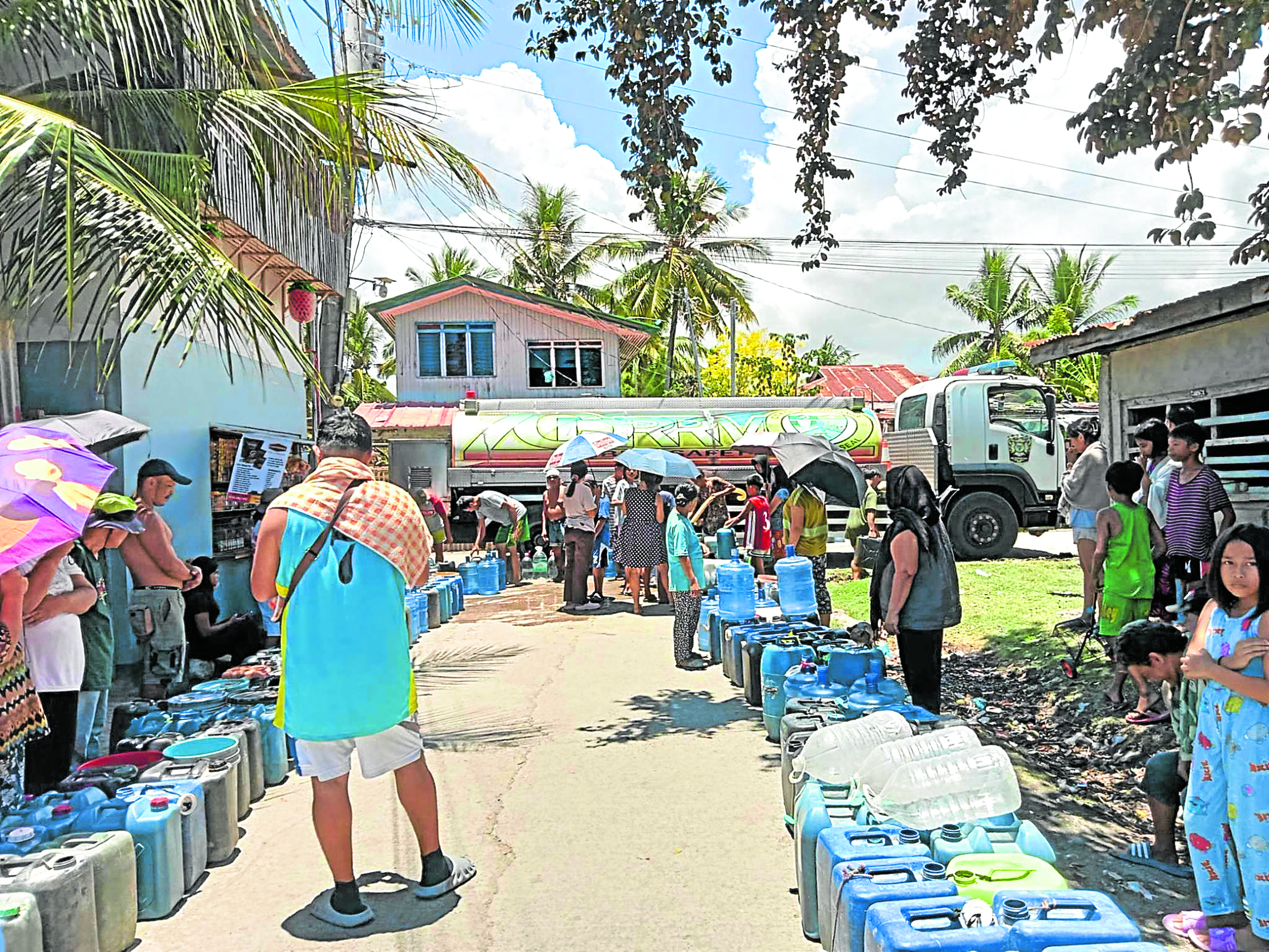Water lack now ‘public safety issue’ in Zamboanga City

‘WATERLESS’ SINCE MARCH A truck arrives to provide water in this village in Zamboanga City where residents have formed a line with their containers. —JULIE S. ALIPALA
ZAMBOANGA CITY — Amid the intense heat brought about by the El Niño phenomenon, water has become a critical resource in the Visayas and Mindanao that residents in Zamboanga City, for example, have resorted to pilfering water from distribution facilities, as they themselves admit.
Zamboanga’s police chief herself, Col. Kimberly Molitas, has described the water crisis as a “public safety issue.” The city, after all, has been under a state of calamity since March.
READ: Task Force El Niño issues tips to save water during dry season
A college student who identified himself only as Kier said he and his other schoolmates search for broken pipes so they can gather water to bring home.
The alternative is to buy water at P25 per “bidon” (vessel), which can store 25 to 30 liters, so he can take a bath. Kier said he used to buy two bidon a day for drinking and for bathing.
Article continues after this advertisementIn the village of Campo Islam, residents steal water from Zamboanga City Water District (ZCWD) lines in the neighboring barangay of Baliwasan.
Article continues after this advertisementAl-Binmar Sulayman Andas, a student at Western Mindanao State University, said the pipes are forcibly opened, then fixed after the containers brought by the residents are filled.
READ: Metro Manila residents told to save water
“The situation is getting tense everyday as more people seek water. Sometimes they compete over the pipes which are not theirs, in the first place,” Andas told the Inquirer.
But other families would rather wait for the delivery trucks to avoid tension, he said.
‘Aware of situation’
Molitas said she has fielded officers to accompany ZCWD personnel who are doing the rounds in water rationing.
“Our police stations are very familiar with the places where there’s supposed to be lack of water. So our station commanders are aware of this [situation],” she said regarding reports of residents pilfering water.
The police chief said she has also tapped the help of barangay officials in monitoring if there is unrest in their villages.
“We don’t have to resort to arms to address this crisis,” Molitas said.
“We are mandated to secure all the people who are rationing water. We do regular assessments. We will take action if necessary if there is any civil unrest,” she added.
In an interview, ZCWD spokesperson Raul Ruben Rivera Jr. said 69,569 households in the city are connected to the district’s distribution system.
But because of the water shortage due to the dry spell, he said the agency can only serve 47,713 households at a decreased pressure and volume.
From a normal level of 74.2 meters, water in ZCWD’s water treatment facility has gone down to 73.88 m. Because of the scarcity, the rest of ZCWD’s service area have no water flowing out of the faucets and have to be served by water lorries, Rivera said.
Mayette Tumarao, a resident of Barangay San Roque, said taking a bath has become a luxury.
“We have been waterless for about a month now. We tried to save as much water and my priority is my son who is going to school every day. I have to stay home and maximize whatever we have here, recycle water so we can also have it for other uses,” the mother of two told the Inquirer.
In the past two weeks, Zamboanga City had an average heat index of 40 degrees Celsius. But this reached 43 C on March 25 and March 31, according to Allan Rommel Labayog, a science research specialist at the Zamboanga station of the Philippine Institute of Volcanology and Seismology.
No water upland
In Cebu City, Mayor Michael Rama has declared a water crisis after water sources in some mountain villages have dried up, with upland residents now lining up for water rations brought by delivery trucks.
Last week, the Cebu City council placed the mountain villages under a state of calamity. And early this week, Rama held a meeting with the department heads of the city government, inviting as well experts such as Oscar Tabada, former Visayas chief of state weather bureau Philippine Atmospheric, Geophysical and Astronomical Services Administration.
“We’re briefed as to what is still going to happen and when this will possibly end. That is the worry we have to be bringing to the [attention of the] public. But nothing to be much alarmed [about] because the city government, with the help of the council, [is doing something],” the mayor said.
Irrigation support
In Ifugao province, farmers in Mayoyao town have been provided irrigation materials after their farms were damaged by drought, the Department of Agriculture (DA) said on Friday.
The municipal government has yet to release details regarding the damage to agricultural land in the 27 villages in Mayoyao and the impact of the drought on the town’s rice terraces.
The Mayoyao terraces are part of the Ifugao rice terraces, which the United Nations Educational, Scientific and Cultural Organization declared a World Heritage Site in 1995.
The fourth-class municipality has a population of 15,621 as of the 2020 census.
Jennylyn Dawayan, director of DA-Cordillera, said Mayoyao was given 53 rolls of high-density polyethylene pipes so that access to alternative water sources can be extended to the municipality.
She said DA is also prepared to distribute buffer seed stocks once the dry spell eases. Farmers were also allowed to start replanting crops like vegetables and rice. —WITH A REPORT FROM VINCENT CABREZA